|
Body Measurements
- The measuring of body parts can be tricky when wanting to record the precise size and measurements of specific muscles. For those it is important to be big, have the most physical stunning and largest physiques, and of course large muscles. While for other it is important for their physical being and body parts to be symmetrical and in proportion to the rest of their body. - By determining the size and circumference of each muscle, it can help an individual determine which part of their body that they need to work on while in the gym and how to get their physique back into a symmetrical state. Correctly measuring your body parts and muscle size is also important in determining clothing size. -Tips : 1.) Stay completely relaxed and still during measurements - By performing measurements in a relaxed state, this guarantees instant and correct results rather than having to judge from flexed or full muscles. The human body has a natural tendency to flex or become stiff which will then generate incorrect measurements, thus it is important to stay relaxed and still to make sure that these readings are clear and concise. 2.) Don't Exercise Before Measurements - Exercising before measuring bodyparts can cause uneven measurements due to certain muscles being fuller and distorting the overall result of the readings. It is important to get a natural reading of the size of the muscles rather than trying to overcompensate for size immediately after a workout. 3.) Measure Both Sides - It is important to measure both sides of the body to make sure that all measurements are in perfect symmetry and that there is a balance between your body parts. 4.) Do Not Tighten the Tape - Tightening the tape during measurements can tighten the muscles as well as stretch the tape thus giving inaccurate readings. 5.) Keep Track of Measurements -It is important to store and keep track of all measurements and readings to see the progress and growth in your muscles from workouts or can take note on which muscles need improvement. - Tools that can be used : Measuring Tape, String, Ribbon, Calipers and Clamps Body Fat Percentage
- Measuring Body Fat Percentage can help an individual determine the percentage of lean muscle mass they have compared to the amount of actual body consisted of in their bodies. - Parts To Take Measurements : 1.) Back of the Arm - When measuring this section of the arm you want to locate the spot between the elbow and the shoulder blade, near the fullest part of the tricep muscle. Pinch the skin in a vertical position, place the caliper over the selected section and record data. 2.) Front of the Arm - To measure the front of the arm, follow the same steps as the back of the arm but start in the location between the shoulder and elbow on the front of the arm. Locate the fullest part of the bicep muscle, vertically pinch the skin, place the caliper over the selction and record data. 3.) Waistline - On the waistline, you want to start your measurements right above your hips, directly across from your belly button and just above the pelvic bone. Pinch the skin horizontally and record your data. 4.) Behind the Shoulder Blade - To get your measurements for this part, locate the area just right below one of your shoulder blades and pinch the skin in an angled position. From there take the caliper and record your data. - After recording the data, you take the sums of the numbers 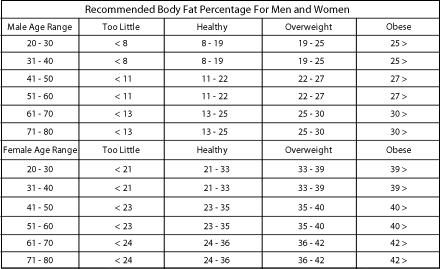
- Normal Body Fat Percentage : Men - For men between the ages of 20 and 40 the typical body fat percentage that is considered healthy is around 8 to 19%. From the ages of 41 to around 60 the average and healthy body fat percentage is 11 to 22% and men from the ages of 61 to 80 are considered to have a healthy body fat percentage if it is between 13 and 25%. An individual wants to keep their body fat percentage from reaching the upper limits of overweight and obesity as well as not going extremely below the lower limits as these can be considered unhealthy body fat percentages. Those who are in the lower limits or having too little body fat percentage are classified as being lean. Women - On the otherhand for women within the age range of 20 to around 40 have a healthy body fat percentage when it is between 21 and 33%. Women of the age of 41 and 60 years old are considered healthy when their percentage is between 23 and 35%. Finally for those women who are 61 to 80 years of age have a healthy body fat percentage when it ranges from 24 to 36%. As the same with men, a women wants to keep their body fat percentage from reaching the upper limits of becoming overweight or considered obese, and do not want to go way below their lower limits. - Tips : The main tool used to measure body fat percentage are calipers. - When taking measurements of the specific sections on the body, pull out a layer of skin with one of your hands and pinch the layers of fat to be easily recorded with the caliper. Then take the caliper, place the jaws right on the skin and squeeze, taking the data records down. - As you are clamping down and recording information, do not release the pinch on the skin and keep a tight squeeze until records are complete. - Keep the body relaxed while pinching the skin and recording measurements - Always double check your data Shoulders
- To measure shoulder width and size 1.) The tape must be measured from the tip of one shoulder to the tip of the other shoulder, where the horizontal plane of the shoulder intersects with the vertical plane of the arm. 2.) This measurement should go horizontally across the back from the tip of each shoulder to get the correct width. 3.) Then take the tape and wrap it around the chest keeping it snug and return back to the starting point on the opposite shoulder - Tips : It is important to stand still, up straight, and stay completely relaxed to get the right measurements. - Also keep the tape measure snug to make sure you are getting an accurate reading. - Always double check measurements 
Biceps
- There are 2 various ways to get bicep measurements 1.) Straight Arm Bicep - Keep your arm by your side, stay relaxed and measure around the fullest part of the bicep. 2.) Flexed Bicep - Extend your arm straight out horizontally at your side. Take the tape measure and wrap it around the fullest and most peak part of your bicep. Then flex your bicep by making a fist and tensing up the bicep and triceps as much as possible. - Tips : It is important to stand still, up straight, and stay completely relaxed to get the right measurements. - Also keep the tape measure snug to make sure you are getting an accurate reading. - Always double check measurements 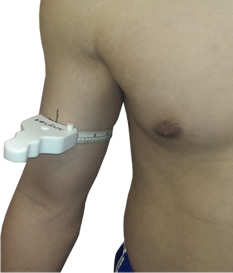
Calves
- There are 2 various ways to get calf measurements 1.) Straight Relaxed Calf - Beginning measurement on the calves, start at one of your legs and about 2 inches below the bottom of the knee cap. Take the measuring tape and wrap it around the fullest part of the calf muscle. 2.) Flexed Calf - Beginning measurement on the calves, start at one of your legs and about 2 inches below the bottom of the knee cap. Take the measuring tape and wrap it around the fullest part of the calf muscle. After wrapping it around, flex the calf muscle keeping it as tight as possible and record measurement. - Tips : It is important to stand still, up straight, and stay completely relaxed to get the right measurements. - Also keep the tape measure snug to make sure you are getting an accurate reading. - Always double check measurements 
Chest
- When measuring chest size it is important to : 1.) Start off standing up straight with your arms by your sides and being completely relaxed. 2.) Then with a measuring tape, start from underneath one armpit and wrap it around the largest part of your chest to other side of your armpit. 3.) From there go around the back making sure the tape is wrapped across your shoulder blades to get the full size of the chest. - Tips : It is important to stand still, up straight, and stay completely relaxed to get the right measurements. - Also keep the tape measure snug when measuring chest and not too tight as that gives off incorrect readings. - Always double check measurements 
Forearms
- To measure the size of the forearm : 1.) start on one arm right at the elbow and go down about 2 inches to the fullest part of the muscle. 2.) From there take the tape measure and wrap it around the forearm to get the correct circumference and measurement. - Tips : It is important to stand still, up straight, and stay completely relaxed to get the right measurements. - Also keep the tape measure snug to make sure you are getting an accurate reading. - Always double check measurements 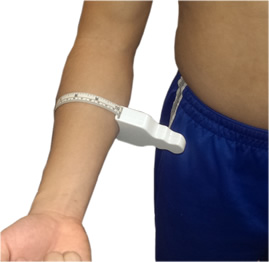
Hips
-Measuring the hips is quite tricky as most people assume that the waist line area is where you would get your measurement for the hips. 1.) To correctly measure the size of one's hips, begin about 6 inches right below the belly button right at your pelvis. 2.) Start at one side of your pelvis right where your hip bones jut out and wrap the tape around your back, just above your glutes until you reach the other pelvic bone. 3.) From there finish up by wrappping the remaining amount of tape til it reaches the starting point to get the correct measurement. - Tips : It is important to stand still, up straight, and stay completely relaxed to get the right measurements. - Make sure you are measuring below the belly button and not right at it or above. This is your hip area, not the waist. - Also keep the tape measure snug to make sure you are getting an accurate reading. - Always double check measurements 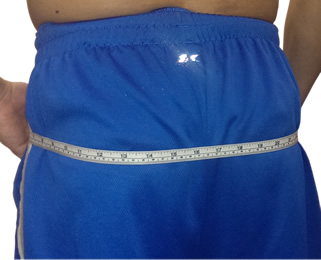
Neck
- When measuring the circumference of the neck you want to : 1.) Begin in the front near the Adam's apple. 2.) Take the tape and wrap it clockwise around the neck making sure there is no space between the tape measure and the muscle. 3.) Come back around to the beginning and line up with the original starting point to get the final measure for the neck. - Tips : It is important to stand still, up straight, and stay completely relaxed to get the right measurements. - Also keep the tape measure snug to make sure you are getting an accurate reading. - Always double check measurements 
Thighs
- Measuring the thigh you want to 1.) Begin at your hip and go down one leg to the fullest part of the muscle, just below the pelvis and right above the knee. 2.) Stand fully still, take a measuring tape and begin at the front of the muscle near the quad. 3.) From there wrap the tape around the back of the muscle making sure that you stay within the fullest part of the muscle for measurement and return back to the beginning. 4.) Mark down your final results. - Tips : It is important to stand still, up straight, and stay completely relaxed to get the right measurements. - Also keep the tape measure snug to make sure you are getting an accurate reading. - Always double check measurements 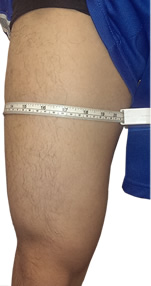
Waist
- The measurement of the waist area is one of which many are concerned over and can be confused with the measurements of the hips and is important in determining the size of clothing. 1.) When measuring the waist you want to stand up straight and begin around the belly button area, no further down than the belly button. 2.) Start the measuring tape right around the belly button and wrap it around clockwise keeping a snug fit around the waistline area. 3.) Return back to the starting position making sure that there is no loose spots within the measuring tape and record the fine measurement. - Tips : It is important to stand still, up straight, and stay completely relaxed to get the right measurements. - Start right at the belly button, as this is the waist line area, any further down and you are heading towards the hips. - Have somebody help you with the measurements or do it in front of a full length mirror to make sure that the recordings are accurate. - Also keep the tape measure snug to make sure you are getting an accurate reading. - Always double check measurements 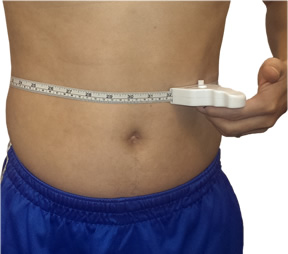
|